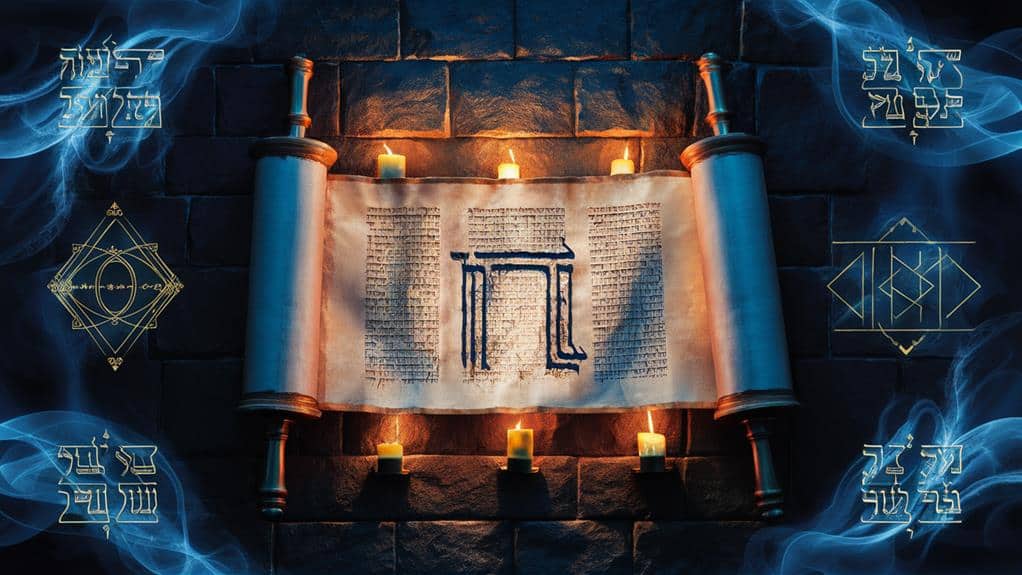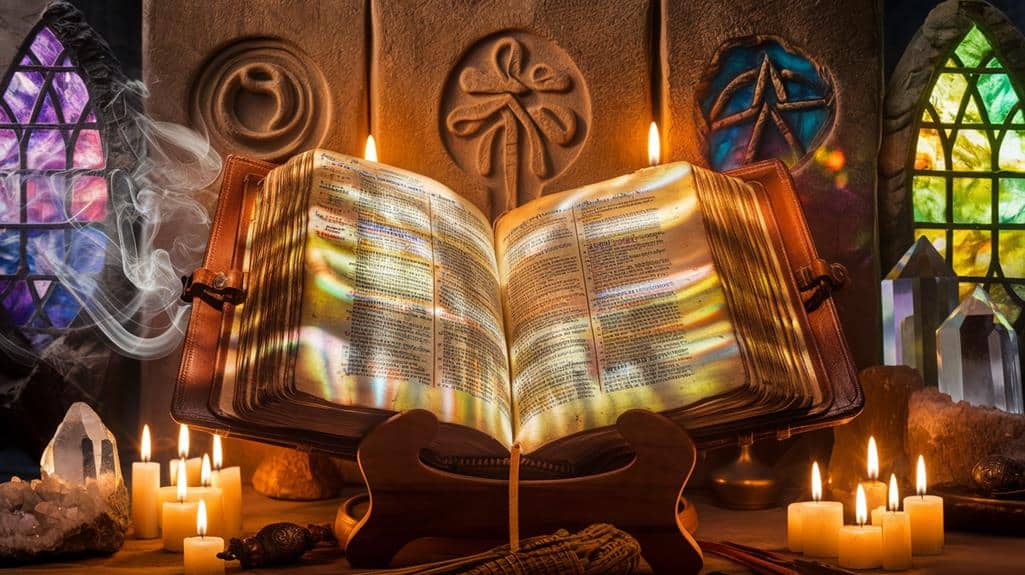What Is the Mysticism Bible ?
You’ve likely encountered references to biblical mysticism without fully grasping its profound significance. The Mysticism Bible isn’t a separate text but rather an approach to understanding sacred scriptures through direct, experiential connection with the Divine. It’s where ancient wisdom meets personal transformation, offering you pathways beyond literal interpretations into deeper spiritual domains. Through mystical perspectives, familiar passages reveal hidden meanings and practical methods for achieving divine union. Whether you’re a seasoned spiritual seeker or simply curious about transcendent dimensions of faith, this exploration will illuminate the transformative power lying dormant in traditional biblical texts.
Origins of Biblical Mysticism

From the earliest days of ancient Israel, Biblical mysticism emerged as a profound spiritual practice focused on direct, experiential knowledge of the Divine. You’ll find its roots deeply intertwined with the prophetic traditions, where figures like Ezekiel and Isaiah experienced powerful visions that transcended ordinary consciousness and revealed celestial mysteries.
As you explore these ancient origins, you’ll discover that Biblical mysticism wasn’t confined to elite religious circles. It developed through various streams of Jewish spiritual thought, including the merkavah (divine throne) traditions and early forms of Kabbalah. These practices emerged from the burning desire to bridge the gap between human limitation and divine infinity.
You’re inheriting a tradition that evolved through the temple period, where priests and prophets engaged in meditation, contemplative prayer, and sacred rituals designed to pierce the veil between worlds.
The mystical interpretations of Scripture, particularly in texts like Song of Songs and Genesis, gave birth to powerful techniques for spiritual awakening. These methods weren’t meant to escape reality but to penetrate its deepest layers, revealing the divine presence woven into the fabric of existence.
Key Mystical Passages
Throughout the Bible, mystical passages serve as gateways to profound spiritual experiences and divine revelation. You’ll discover transcendent moments in texts like Ezekiel’s vision of the divine chariot, where wheels within wheels move in supernatural harmony, and John’s apocalyptic revelations on Patmos paint cosmic scenes beyond ordinary comprehension.
In the Song of Songs, you’ll encounter mystical love poetry that speaks to the soul’s intimate union with the divine, while the Psalms reveal deeper dimensions of spiritual ecstasy through poetic expressions of divine encounters.
The Gospel of John opens with the mystical Logos doctrine, inviting you to contemplate Christ as the eternal Word made flesh. Paul’s description of being “caught up to the third heaven” in 2 Corinthians 12 exemplifies direct mystical experience.
Moses’ encounter with the burning bush and Isaiah’s vision in the temple represent transformative moments where the material and spiritual domains intersect.
These passages don’t just tell stories; they’re portals through which you can access deeper spiritual truths and experience divine mysteries firsthand, transcending ordinary religious understanding to embrace direct spiritual knowing.
Major Themes and Symbols

Biblical mysticism weaves together recurring symbols and themes that point to transcendent realities beyond ordinary perception. You’ll discover profound metaphors like light piercing darkness, living water flowing from divine sources, and sacred mountains where heaven meets earth. These symbols aren’t mere literary devices – they’re gateways to deeper spiritual truths that resonate across time and culture.
As you explore the mystical dimensions of scripture, you’ll encounter transformative themes that challenge your understanding of reality. The concept of divine union emerges repeatedly, whether through the Song of Solomon’s passionate imagery or Jesus’s promise that you’ll become one with him as he’s one with the Father.
You’ll find the theme of death and rebirth woven throughout – not just physical death, but the dying to self that precedes spiritual awakening. The symbol of the temple evolves from a physical structure to your own body as God’s dwelling place, while the recurring motif of the wilderness represents both spiritual testing and intimate divine encounter.
Each symbol and theme invites you deeper into the mystery of divine presence and spiritual transformation.
Historical Mystical Interpretations
Jewish and Christian mystics have interpreted sacred texts through profound spiritual lenses across millennia. You’ll find that these interpretations transcend literal readings, revealing hidden layers of meaning that point to direct communion with the Divine.
Through practices like lectio divina and kabbalistic meditation, mystics have discovered pathways to transformative spiritual experiences within scripture’s depths.
When you explore these mystical interpretations, you’ll encounter recurring patterns – numbers that unveil cosmic significance, letters that contain divine energy, and words that serve as gates to higher consciousness.
The medieval Kabbalists found God’s nature encoded in every Hebrew letter, while Christian contemplatives like Meister Eckhart saw Christ’s eternal birth occurring within the human soul through scripture’s living word.
You’ll notice how these interpretations often challenge conventional religious authority, offering direct spiritual access rather than institutional mediation.
Modern mystics continue this tradition, finding fresh meaning in ancient texts through contemplative practice and inner revelation.
These approaches invite you to move beyond surface meaning into scripture’s transformative core, where you might discover your own direct connection to sacred reality.
Mystical Practices and Techniques

When mystics engage with sacred texts, they employ specific practices designed to reveal deeper spiritual dimensions. You’ll find that these techniques often include contemplative reading (lectio divina), where you’ll dwell on individual passages until they begin to speak to your inner being.
Through meditative visualization, you’re encouraged to place yourself within biblical narratives, experiencing them as a present reality rather than distant history.
You’ll discover that breath work and sacred chanting play significant roles, as you’ll often synchronize your breathing with scripture recitation or use ancient Hebrew and Greek phrases as mantras.
These practices aren’t merely intellectual exercises – they’re gateways to transformative experiences. You’ll learn to practice centering prayer, where you’ll sit in silence, letting go of thoughts while holding a sacred word as an anchor.
Through contemplative writing, you’ll engage in spiritual journaling, recording insights that emerge during your mystical encounters with scripture.
The goal isn’t to accumulate knowledge but to facilitate direct, experiential communion with the divine presence that mystics believe permeates every word of sacred text.
Notable Christian Mystics
Throughout history, Christian mysticism has been shaped by influential figures who’ve left lasting legacies of spiritual insight and contemplative practice.
You’ll discover profound wisdom in the works of Meister Eckhart, whose radical teachings on divine union challenged medieval orthodoxy, and Teresa of Ávila, who mapped the soul’s interior castle through seven dwelling places of deepening awareness.
John of the Cross’s “Dark Night of the Soul” will guide you through spiritual transformation‘s challenging terrain, while Julian of Norwich’s revelations of divine love offer you comfort in contemplating God’s maternal nature.
You’ll find Hildegard of Bingen‘s visionary experiences woven through her music, art, and writings, demonstrating how mystical insight can flow through multiple channels of creative expression.
In modern times, Thomas Merton‘s writings bridge Eastern and Western contemplative traditions, showing you how ancient mystical practices remain relevant today.
Through these mystics’ experiences, you’ll understand that the path to divine union isn’t merely historical but remains vibrantly accessible.
Their collected wisdom forms a living tradition that continues to illuminate the way for those seeking direct spiritual experience.
Divine Union Teachings

The teachings of Christian mystics converge on one central aim: achieving divine union with God. Throughout the mystical texts, you’ll find recurring themes of dissolving the boundaries between your individual consciousness and the Divine presence, leading to a profound state of oneness that transcends ordinary perception.
You’ll discover that divine union isn’t merely an intellectual concept but a transformative experience that mystics describe as being “lost in God.” This sacred marriage between your soul and the Divine requires letting go of your ego-centered existence and embracing what mystics call “holy darkness” – a state where you’re stripped of familiar reference points and opened to direct divine experience.
The path to divine union involves specific spiritual practices: contemplative prayer, where you’ll learn to rest in silent receptivity; meditation on sacred texts, which opens your heart to divine wisdom; and the practice of self-emptying, where you’ll release attachments that separate you from God.
These teachings emphasize that union with God isn’t reserved for an elite few – it’s your natural inheritance, accessible through dedicated spiritual practice and an open heart.
Mystical Encounters in Scripture
Biblical texts overflow with profound mystical encounters between humans and the Divine, from Moses’s burning bush to Paul’s blinding vision on the Damascus road. Throughout scripture, you’ll discover transformative moments where ordinary people come face-to-face with extraordinary manifestations of God’s presence, forever altering their understanding of reality and their place within it.
You’ll find Jacob wrestling with an angel until daybreak, emerging transformed with a new name and identity. Isaiah’s vision in the temple reveals the overwhelming glory of the Divine, where seraphim cry “Holy” and the prophet’s lips are cleansed with burning coal.
In the New covenant, you’ll encounter John’s apocalyptic visions on Patmos, where heaven’s veil parts to reveal cosmic mysteries and divine purposes unfolding through time. These encounters aren’t merely historical accounts – they’re archetypal patterns of how the Divine breaks into human consciousness, offering you glimpses into domains beyond ordinary perception.
Each mystical encounter invites you to recognize that your own spiritual journey might include similar moments of divine revelation, where the boundaries between heaven and earth become permeable, and you’re drawn into deeper communion with the Sacred.
Modern Mystical Understanding

Modern interpretations of biblical mysticism bridge ancient wisdom with contemporary spiritual consciousness, offering fresh perspectives on timeless encounters with the Divine. You’ll find that today’s understanding embraces both traditional and innovative approaches, allowing you to explore sacred texts through multiple lenses of perception and experience.
When you investigate modern mystical interpretation, you’re connecting with a dynamic tradition that’s evolved beyond literal readings to encompass psychological, metaphorical, and transpersonal dimensions. You’re invited to discover how ancient mystical experiences resonate with contemporary spiritual practices, from contemplative prayer to mindfulness meditation.
Through this modern lens, you’ll recognize that mystical encounters aren’t limited to biblical figures – they’re accessible aspects of your own spiritual journey. You’re part of an ongoing dialogue between timeless wisdom and present-day consciousness.
Whether you’re studying prophetic visions, angelic encounters, or divine revelations, modern mystical understanding encourages you to integrate these experiences into your personal spiritual framework. This approach doesn’t diminish traditional interpretations but rather expands them, creating space for deeper, more nuanced engagement with sacred mysteries.
Living the Mystical Path
Spiritual seekers who embrace mystical teachings often discover that living the mystical path requires both dedication and practical application in daily life.
You’ll find that this journey transforms your ordinary experiences into opportunities for profound spiritual growth, as you learn to perceive the sacred within the mundane.
To walk the mystical path, you’ll need to cultivate specific practices that deepen your connection to the divine.
Begin with regular meditation, allowing yourself to sink into states of contemplative awareness where you can directly experience the mysteries that lie beyond intellectual understanding.
You’ll discover that maintaining a journal of your spiritual insights helps integrate these experiences into your daily consciousness.
As you progress, you’ll notice that your relationships and daily activities become infused with deeper meaning.
You’re no longer simply performing tasks or interacting with others – you’re participating in a sacred dance of interconnected consciousness.
This shift in perspective doesn’t require you to withdraw from the world; instead, it invites you to engage more fully while maintaining an awareness of the divine presence that permeates all existence.
Conclusion
You’ll find that the Mysticism Bible isn’t just a sacred text, but a transformative gateway to deeper spiritual understanding. As you engage with its ancient wisdom through contemplative practices, you’re stepping into a rich tradition that connects you with countless mystics who’ve walked this path before. Whether through lectio divina or silent meditation, you’re invited to discover the profound mysteries that await in these sacred pages.









